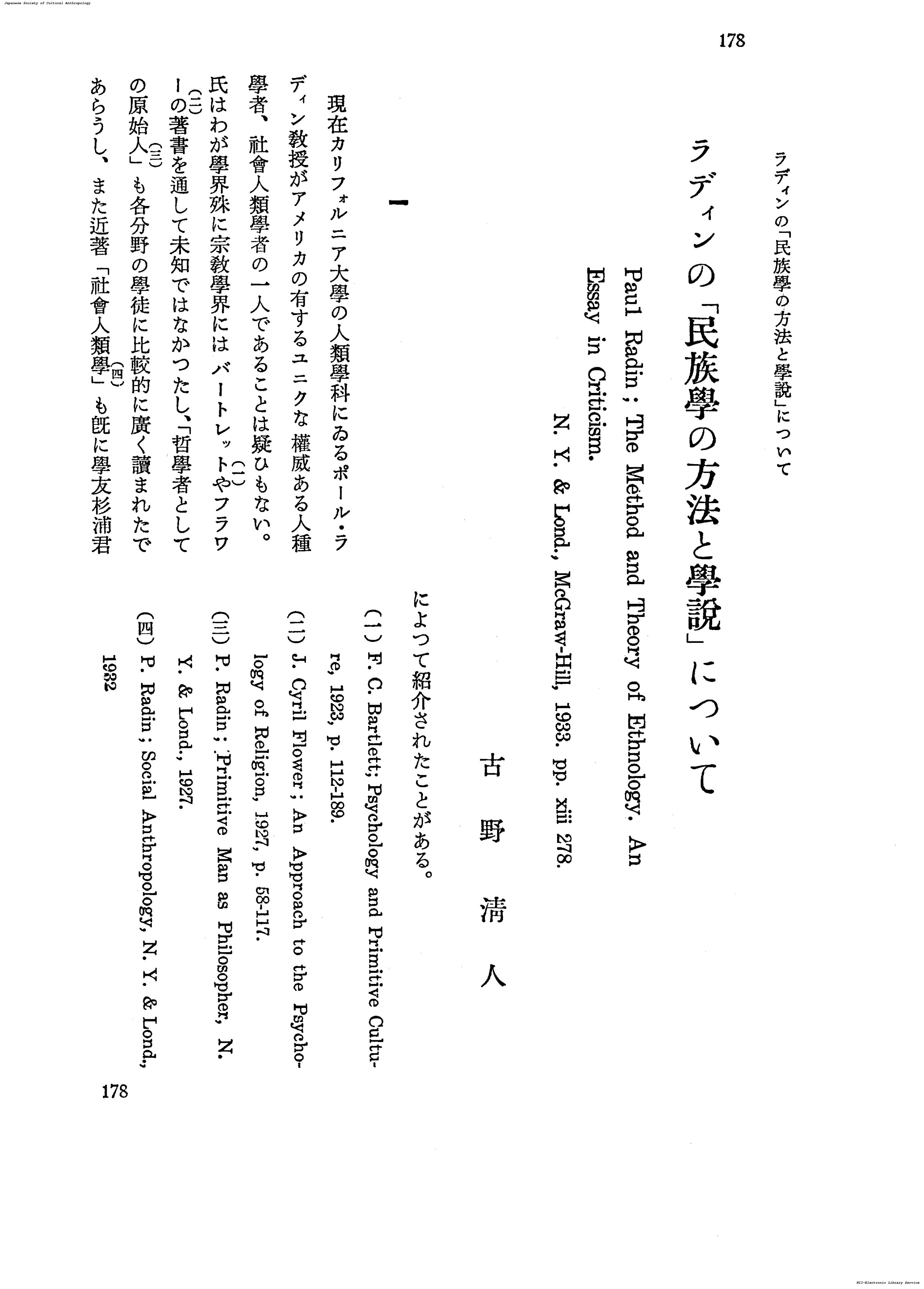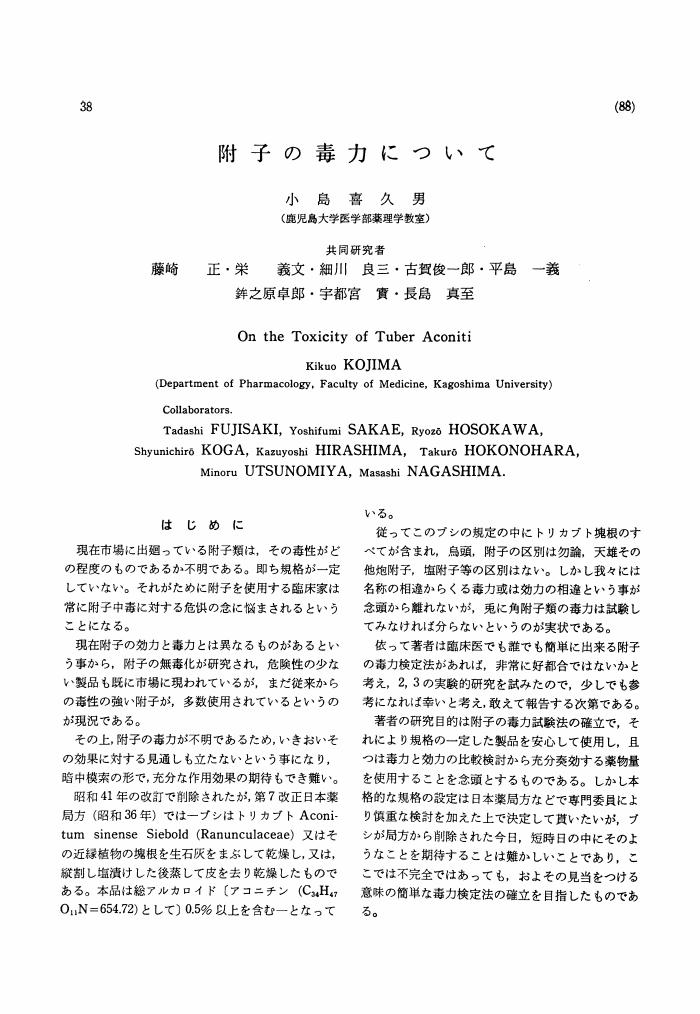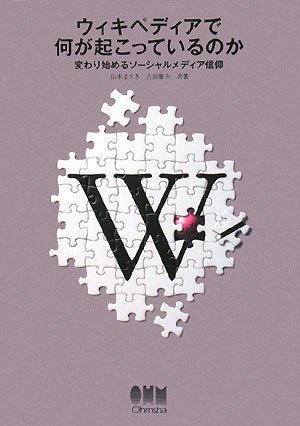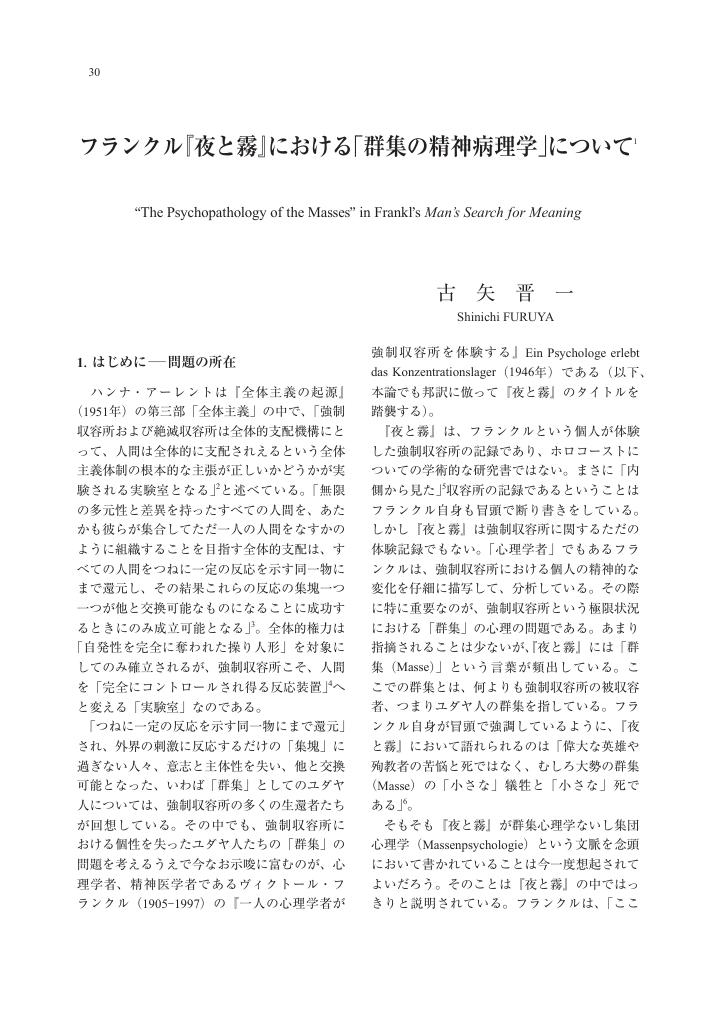1 0 0 0 OA レヸ・ブリュル「原始的神話學」について
- 著者
- 古野 清人
- 出版者
- 日本文化人類学会
- 雑誌
- 民族學研究 (ISSN:24240508)
- 巻号頁・発行日
- vol.1, no.3, pp.547-554, 1935-07-01 (Released:2018-03-27)
- 著者
- 古野 清人
- 出版者
- 日本文化人類学会
- 雑誌
- 民族學研究 (ISSN:24240508)
- 巻号頁・発行日
- vol.1, no.2, pp.384-386, 1935-04-01 (Released:2018-03-27)
- 著者
- 古野 清人
- 出版者
- 日本文化人類学会
- 雑誌
- 民族學研究 (ISSN:24240508)
- 巻号頁・発行日
- vol.1, no.2, pp.389-390, 1935-04-01 (Released:2018-03-27)
- 著者
- 古野 清人
- 出版者
- 日本文化人類学会
- 雑誌
- 民族學研究 (ISSN:24240508)
- 巻号頁・発行日
- vol.1, no.1, pp.199-200, 1935-01-01 (Released:2018-03-27)
1 0 0 0 OA ラディンの「民族學の方法と學説」について
- 著者
- 古野 清人
- 出版者
- 日本文化人類学会
- 雑誌
- 民族學研究 (ISSN:24240508)
- 巻号頁・発行日
- vol.1, no.1, pp.178-184, 1935-01-01 (Released:2018-03-27)
1 0 0 0 OA 附子の毒力について
- 著者
- 市古 勲
- 出版者
- 日本経営学会
- 雑誌
- 經營學論集 第89集 日本的経営の現在─日本的経営の何を残し,何を変えるか─ (ISSN:24322237)
- 巻号頁・発行日
- pp.67-79, 2019 (Released:2019-09-26)
本稿は,かつて存在し,日本企業の強みの源泉であったと考えられている「会社主義」が,現在はどのような形態に変化し,また,その機能状態がどうなっているのかを調査・考察するものである。調査・考察するにあたっては,可能な限り長いスパンで定点的に行われている種々のアンケート・データと,筆者が行ったインタビュー調査を使用した。主な結論は次の通りである。まず,日本企業の被用者らの「終身雇用」,「年功序列」に対する意識は,おおむね肯定的であり,現在においてもその雇用形態を望む声が多い。しかし,会社そのものへの帰属意識や忠誠心は,世代を経るにつれて希薄になっている。一方,企業側は,ステークホルダーとして従業員を重視する姿勢は見せつつも,景気・業績の状況に応じて人員調整をしているケースが多い。以上の事から,現状において,「会社主義」的な特徴は,形としては観察されるものの,その内実はかつてのものとは異なっており,それ故に,日本企業の強みの源泉として機能しているとはいえそうにない。
1 0 0 0 OA 定住者の知と交流の論理 ―愛知県矢作川の事例から―
- 著者
- 古川 彰
- 出版者
- 東北社会学会
- 雑誌
- 社会学年報 (ISSN:02873133)
- 巻号頁・発行日
- vol.36, pp.7-29, 2007-07-20 (Released:2013-09-20)
- 参考文献数
- 14
本稿の目的は主に愛知県矢作川流域の所有,管理,利用にかかわる関係主体(アクター)の歴史過程の検討を通して,定住者(コミュニティ)の知と交流の論理について議論することである.とくに本稿では,河川環境保全主体としては注目されてこなかった内水面漁協,河川につよい権利を持つ農業水利団体,河川管理者としての行政,そして環境保全などにつよい関心をもって1980年代から登場する市民グループとの関わりの変化に焦点をあてて記述,分析をおこなった. その結果,1990年代以降の河川の環境化によって,諸アクターの活動は流域社会へと開かれ(流域社会化),それぞれのコミュニティに固定化されてきた範域的な関係主体(アクター)が,多様なアクターと関係を取り結ぶことで,アクター間の垣根を低くしてゆるやかに結ばれる関係的なアクターへと変化し,あらたな開かれたコミュニティを形成しつつあるプロセスを明らかにした.
1 0 0 0 OA 元朝~明朝初期の言語接触に関する文献学的研究
1 0 0 0 OA 急性脳炎における髄液中サイトカイン
- 著者
- 市山 高志 西河 美希 林 隆 古川 漸
- 出版者
- 一般社団法人 日本小児神経学会
- 雑誌
- 脳と発達 (ISSN:00290831)
- 巻号頁・発行日
- vol.29, no.6, pp.466-470, 1997-11-01 (Released:2011-08-10)
- 参考文献数
- 20
急性脳炎において, 局所の免疫・炎症病態を検討するため, 急性期の髄液中のinter-Ieukin-1β (IL-1β), IL-6, tumor necrosis factor-α (TNF-α), soluble TNF receptor1 (sTNF-R1) をsandwich enzyme-linked immunoassay法で測定した.対象は急性脳炎の24名で, 神経学的後遺症の有無により予後不良群9名, 予後良好群15名に分けて検討した.IL-1β, IL-6, TNF-α, sTNF-R1とも対照群 (23名) に比して予後不良群, 予後良好群とも有意に高値を示した.またsTNF-R1は予後不良群が予後良好群より有意に高値を示した.以上からIL-1β, IL-6, TNF-αは急性脳炎の炎症・免疫病態に関与しており, また急性期の髄液中sTNF-R1値は神経学的予後を推測しうる指標になると考えた.
1 0 0 0 OA Yu.オレーシャ『羨望』の草稿における主人公と語り手の問題
- 著者
- 古宮 路子
- 出版者
- ロシア・東欧学会
- 雑誌
- ロシア・東欧研究 (ISSN:13486497)
- 巻号頁・発行日
- vol.2015, no.44, pp.56-69, 2015 (Released:2017-08-18)
- 参考文献数
- 8
Yury Olesha completed Envy, his first novel, after repeated trial and error in terms of the form of narrative. The novel consists of two parts, with a change in the narrator from Nikolai Kavalerov, the hero, in the first part to the author in the second. However, it is not clear why Olesha changed the form of narrative and the narrator in the second part of Envy. Upon inspection of the book’s previous drafts, it becomes apparent that Olesha tried various forms of narrative in the process of writing. This study attempts to clarify the reason of change in the form of narrative in the published version, judging from the reason of change in the form of narrative in the drafts. From multiple types of drafts, this study picked up three groups of drafts that were written in the three different stages of writing. The fragmental chapter “Useless Things” can be regarded as the first stage, in which the hero is not Kavalerov but Ivan Babichev, one of the main characters in the final draft. In “Useless Things,” Olesha introduces Zvezdarov as a narrator and gradually gives him a personality as powerful as that of Ivan Babichev. As a result, the former becomes as important as the latter. However, it seems that Olesha still wanted to present Ivan Babichev as the hero. Therefore, in the second stage, Olesha moves from Zvezdarov to Kavalerov as a neutral narrator to recount Ivan Babichev’s story. Nevertheless, Kavalerov is also gradually given a powerful personality, becoming as important as Ivan Babichev. This may account for Olesha making Kavalerov the hero in the third stage. Instead of Kavalerov, the author begins to use Kavalerov’s neighbor as the narrator. The notable feature of this stage is the relationships of pairs: Kavalerov/Ivan and Kavalerov/his neighbor. Although Olesha ultimately shifted the focus from Ivan Babichev to Kavalerov as a hero in the novel, it appears that he continued to believe the former to be more suitable for the role. Thus, in this stage, Olesha adorns Kavalerov with many features characteristic of Ivan in the previous stage. At the same time, Olesha now found Kavalerov’s personality suited to that of a narrator. Therefore, the author initially made the narrator, Kavalerov’s neighbor, a literary mirror of Kavalerov, as a hero. However, in the end, the author presents Kavalerov with characteristics separate from Ivan, abandons the use of the neighbor as a narrator, and makes Kavalerov both the hero and the narrator. This decision was adopted in the final version as well. The reason for change in the form of narrative and the narrator in the second part of Envy is revealed in the relationship between the hero and the narrator in the earlier drafts. In the second part of the published version, Ivan Babichev’s monologue is of great significance. In other words, Ivan Babichev becomes as important as the hero. As we saw above, Olesha knew that Kavalerov was not a suitable narrator for Ivan’s story. Perhaps this is why Olesha abandoned the use of Kavalerov as the narrator in the second part of the novel. In Envy, the problem of who is the narrator of the story is as important as the problem of who is the hero of the story.
- 著者
- 古川 哲
- 出版者
- ロシア・東欧学会
- 雑誌
- ロシア・東欧研究 (ISSN:13486497)
- 巻号頁・発行日
- vol.2013, no.42, pp.103-120, 2013 (Released:2015-05-28)
- 参考文献数
- 14
It is well known that the style of Andrei Platonov (1899–1951) underwent a notable change during the first half of the 1930s. This article aims to concretely analyze how his writing evolved during this period by comparing two of his novellas: Efirnyi trakt, written in 1927, and Dzhan, written in 1935. These works were written, respectively, before and after Platonov altered his style. However, there is another reason to compare these two works in particular. These novellas have entirely different themes; however, they contain similar elements in their plots. Therefore, they are relatively easy to compare in order to show how the author’s style underwent a transformation. Efirnyi trakt is about physicists who explore a way to increase or decrease materials at will. In contrast, Dzhan is about a youth who is sent from Moscow to rescue an ethnic group that is facing almost certain destruction in the Sary-Kamysh basin in Central Asia. Despite the apparent differences between these two works, each has a protagonist with a high level of education, and who, while eager to accomplish his mission, suffers a setback. A closer look at these works makes it clear that the position of the protagonist in relation to the natural environment undergoes a critical change. In other words, the relationship is turned upside down. In Efirnyi Trakt, the physicists are active agents dealing with the natural environment, and they exploit it for their own gains. In Dzhan, the young man is vulnerable to predation by eagles, and is therefore relatively passive to nature. In Europe after World War I, Platonov was not unique in characterizing the man by putting emphasis on his passiveness. However, Platonov was original in expressing the passivity of man with respect to the natural environment, not only through the expression of feelings and reflections of the protagonists but also by inverting the relationship between his protagonists and the natural environment. A comparison of these two novellas makes this clear. It is well known that since the mid 1930s, Platonov attempted to write works that faithfully accorded with the principles of socialist realism. Yet, despite his efforts, as seen in Dzhan, his own literary cosmos kept evolving.
- 著者
- 山本まさき 古田雄介著
- 出版者
- オーム社
- 巻号頁・発行日
- 2008
1 0 0 0 OA フランクル『夜と霧』における「群集の精神病理学」について
- 著者
- 古矢 晋一
- 出版者
- 日本ユダヤ学会
- 雑誌
- ユダヤ・イスラエル研究 (ISSN:09162984)
- 巻号頁・発行日
- vol.32, pp.30, 2018 (Released:2021-05-09)
1 0 0 0 OA 第12回学術大会報告要旨
- 著者
- 大澤 耕史 古矢 晋一 黒田 晴之
- 出版者
- 日本ユダヤ学会
- 雑誌
- ユダヤ・イスラエル研究 (ISSN:09162984)
- 巻号頁・発行日
- vol.30, pp.81, 2016 (Released:2020-09-26)
1 0 0 0 OA 武道必修化に伴う中学生の剣道イメージに関する研究
- 著者
- 古澤 伸晃 新里 知佳野 八木沢 誠 軽部 幸浩 藤田 主一
- 出版者
- 日本応用心理学会
- 雑誌
- 応用心理学研究 (ISSN:03874605)
- 巻号頁・発行日
- vol.46, no.3, pp.234-246, 2021-03-31 (Released:2021-06-30)
- 参考文献数
- 32
In our study, we examined the psychological structure of junior high-school students participating in compulsory martial arts, focusing on their image of Kendo. Subjects of the survey included 389 students (156 boys, 233 girls, and average age 13.7 ± 0.8 years) enrolled in public junior high-schools in Chiba prefecture. In the 10 sections of the survey form, beginning with the phrase "What is Kendo," we asked the subjects to complete the sentences with what came to their mind. We further requested them to choose one sentence that had the strongest image of Kendo. Subsequently, text mining was performed on all the sentences we obtained, and the extracted words and phrases were factor-analyzed.Consequently, it became clear that the image of Kendo differs depending on whether the subjects had experience in Kendo lessons. Factors such as "Budo, Kiai, and Yuko-datotsu" were recognized by those with Kendo experience, while factors such as "Culture, Reigi (etiquette), and Budo" were recognized by those without Kendo experience. The factor of "Budo" was common for both sets of students with regard to their image of Kendo.
1 0 0 0 OA 発達障害の家族支援における「障害受容」 ― その概念の変遷を巡って ―
1 0 0 0 OA 真空中での光触媒によるコンタミネーション防止実験
- 著者
- 浦山 文隆 古川 睦久 小澤 清 土佐 正弘 木村 秀夫
- 出版者
- 一般社団法人 日本航空宇宙学会
- 雑誌
- 宇宙技術 (ISSN:13473832)
- 巻号頁・発行日
- vol.6, pp.81-86, 2007 (Released:2007-11-16)
- 参考文献数
- 21
- 被引用文献数
- 1 2
宇宙環境下において宇宙機用材料等から放出される分子状汚染物質は宇宙機表面へ付着し,熱制御材の太陽光吸収率の増加や光学系の反射率・透過率の低下を引き起こすことで,ミッションへ悪影響を及ぼすことが知られている.宇宙機表面に対する分子状コンタミネーション付着防止に関する基礎的な知見を得るため,真空中・紫外線照射環境下での光触媒による付着防止実験を行った.コンタミネーションモデル物質として,スクアレン,テトラメチル・テトラフェニル・トリシロキサン,オレアミド,フタル酸ジエチルヘキシルを実験に用いた.また,光触媒には二酸化チタン粒子,二酸化チタンをコーティングした基板を用いた.二酸化チタンには,真空中においてもすべてのモデル物質に対する重量減少効果が観察された.また,二酸化チタンをコーティングした基板については,紫外線照射時間の経過とともに透過率が増加する現象が観察された.
1 0 0 0 OA 2次元適応構造物における可変幾何パラメータを用いた自己システム同定
- 著者
- 仙場 淳彦 古谷 寛
- 出版者
- 一般社団法人 日本航空宇宙学会
- 雑誌
- 宇宙技術 (ISSN:13473832)
- 巻号頁・発行日
- vol.5, pp.1-7, 2006 (Released:2006-01-27)
- 参考文献数
- 15
This research proposes a structural identification method with variable geometric parameters extending the concept of self-identification. The method is formulated by using the change of eigenvalues and eigenvectors according to the change of variable geometric parameters. The method is then numerically examined through the identification of the stiffness matrix of a two-dimensional variable geometry truss. As a result, the stiffness matrix is identified with a set of linearly independent eigenvectors corresponding to the one vibration mode changed by one variable length member of the truss. Also, the results show that the identification performance using only one variable length member is relatively equal to that using three variable stiffness members without geometric change when multiple vibration modes data are available. Further, it is shown that the identification error with the variable length member depends on the vibration mode and the stiffness ratio between the stiffness of the variable length member and that of the other members to be identified. Finally, the increment of degree-of-freedom of the identified matrix to the identification error is investigated.
1 0 0 0 OA 全炭化したCFRPの損耗挙動に関する研究
- 著者
- 奥山 圭一 座古 勝
- 出版者
- 一般社団法人 日本航空宇宙学会
- 雑誌
- 宇宙技術 (ISSN:13473832)
- 巻号頁・発行日
- vol.3, pp.35-43, 2004 (Released:2004-06-23)
- 参考文献数
- 25
- 被引用文献数
- 1 1
軽い熱防御材料は,アブレータを完全に炭化するまで使用することで実現できる.今回,研究対象としたアブレータは,2層式の完全炭化型の炭素繊維強化フェノール樹脂(CFRP)である.アブレータ母材は,炭化材と比較して重い.したがって,母材層を残す従来の設計手法を採用したアブレータは,完全炭化させたアブレータと比較して重くなる.本研究において,全炭化させた2層式アブレータの表面温度は,従来法と比較して大きくなることが確認された.しかしながら,全炭化させた2層式アブレータの表面損耗量は,従来法と大差がなかった.これは,拡散律速領域(700Kから3000K)において,表面損耗量が表面温度の増減に強く影響されないためと考えられる.









